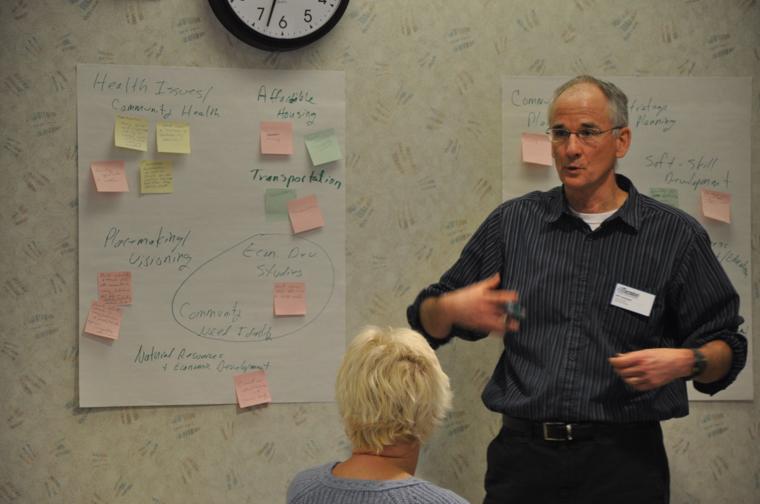By Alexa Zoellner azoellner@dailyunion.com | Posted: Friday, January 12, 2018

VISIONING SESSION
A visioning session to determine the main priorities on which the future Jefferson County University of Wisconsin-Extension Cooperative Extension communities educator should focus took place Thursday.
JEFFERSON — The top three priorities on which the future University of Wisconsin-Extension communities educator in Jefferson County should focus were identified during a visioning session Thursday.
The communities Extension educator will replace the vacant position of community, natural resource and economic development (CNRED) agent in Jefferson County’s UW-Extension Cooperative Extension Office.
The county has been without a CNRED agent since July 2016, when Steve Grabow retired after about 23 years.
Cooperative Extension is one of four divisions that make up UW-Extension. Historically, the programs within the division have included agriculture and natural resource education; CNRED; 4-H and youth development; and family living. How those programs were delivered was up to each county.
Fifteen people participated in Thursday afternoon’s session, which was held at the Jefferson County UW-Extension office in Jefferson.
Leading the discussion were Chrissy Wen, area Extension director for Jefferson, Rock and Walworth counties, and Will Andresen, the interim statewide program director for the CNRED program.
“That term ‘community’ is so broad that I often think, ‘What isn’t it?’” Andresen told the group. “A community can be everything, so it wouldn’t be fair to the community or this person to bring somebody in with that broad expectation.
“We really want to make sure that the relationship is poised for success by really getting a sense from the community of, what are the most crucial needs and opportunities for this position going forward?” he continued. “That’s what today is about.”
The purpose of the communities Extension educators is to “serve as catalysts for positive change by working with Wisconsin communities to address important issues, concerns and opportunities.”
“They aren’t necessarily the change agents by themselves, but they’re working with others to try to address those needs,” Andresen said. “It’s kind of a fluid process. Yes, for sure we’re going to try to bring in somebody that fits what we think are the needs today, but in five years, those needs may change and we’re going to encourage that professional development and growth.”
Although the Jefferson County communities educator wouldn’t be the specialist in “every little thing,” he or she would have access to specialists statewide through the UW System.
“That army of specialists is a big piece of what we can contribute to communities,” Andresen told the group. “Our audiences are businesses, individuals, local government, economic development groups, chambers of commerce. Importantly, we bring research as well as content, and we bring process as well.”
The need for the visioning session arose from the fact that Cooperative Extension currently is in the implementation phase of nEXT Generation, a reorganization that began in the fall of 2015 in response to a $3.6 million cut in funding in the state’s 2015-17 biennial budget.
While the design of the nEXT Generation structure was being determined, many positions in Cooperative Extension offices across the state were left vacant or filled only on interim bases, including three of the four Cooperative Extension agents in Jefferson County.
In May 2016, Sarah Torbert, originally hired in 2013, left her position as 4-H/youth development agent for a statewide position in Wyoming. Grabow retired on July 5, 2016. Kathleen Eisenmann, who began working at UW-Extension in 1995 as Green County’s family living agent and made a lateral transfer to Jefferson County in 2004, retired Dec. 15, 2016.
Jefferson County agriculture agent LaVern Georgson remains in the office. Torbert was replaced on an interim basis by Bruce Jones, whose last day in the office is Jan. 25.
Both Georgson and Jones were present Thursday.
The visioning session lasted about two hours, during which participants helped create and fill “buckets” of community needs, issues and opportunities on which they wished the future communities educator most would focus.
Participants from the community included Joe Nehmer, Jefferson County Parks Department director; Yvonne Duesterhoeft, Jefferson County Veterans’ Services officer; Carol Quest, Watertown Public Health director and board member for the Watertown Health Foundation; Mike Wallace, president and CEO of Fort HealthCare; Jody Knoebel, owner of Jelli’s Market in Helenville; and Mary Ann Jackson, former chairperson of the Arts Alliance and retired Wisconsin technical colleges data administrator.
Also, several elected officials attended, including Hope Oostdik, chairperson of the Town of Lake Mills Board of Supervisors; Jude Hartwick, Fort Atkinson City Council member, and three Jefferson County Board of Supervisors members: Lloyd Zastrow, chairperson of the University Extension Education Committee; Richard Jones, chairperson of the Finance Committee; and Jim Mode, chairperson of the Human Services Board and vice chair of the Human Resources Committee.
Dr. Lynn Brown, district administrator for the School District of Fort Atkinson, was present, but had to leave prior to the discussion to monitor the inclement weather and potential need to close schools early.
The top issue identified was community health, which the group had decided included food systems and affordable housing. Tying for second were community planning/placemaking/visioning and addiction, especially in relation to opioids. Third was workforce development.
• Community health.
Wallace began the “bucket” with the idea of increasing awareness of health issues in Jefferson County and facilitating resolution through existing groups. He also mentioned helping to create a culture of community health.
“We have many groups working on similar issues, and I think back to addiction, but they’re not necessarily working together,” Quest said. “So someone who can strategically bring that work together.”
Wallace noted that, while it’s “great to start a new group,” existing resources should be inventoried and tagged onto when possible.
“When somebody comes into a new community the first two steps are relationship-building and community assessment (of) needs, but also existing responses, gap analysis, how to support existing,” Andresen acknowledged.
Jones connected affordable housing to community health, as well as to addiction.
“Because of the addiction problem, there’s a lot of people on public assistance or homeless,” he said. “(On days like) today, when bad weather’s coming and it’s going to get cold again, your main concern is where you’re going to sleep tonight. A lot of these other things do not matter. I’m not interested in riding a bike if I don’t know where I’m sleeping tonight.”
• Addiction and substance abuse.
Quest said she felt that, because of the prevalence and how widespread of an issue addiction and substance abuse is, it should remain in its own category.
Zastrow used the story of his grandson to help illustrate how prescription opioids addiction can lead into heroin addiction.
“He got hooked on heroin and that’s where he is today,” Zastrow said. “He goes to Dane County every morning at 5:30 a.m. for his therapy and for the medication he needs for that day. He’s down to four days a week now and he’s been doing this for two years.
“I was wishing there was some place closer where he could get this need taken care of without having to go to Dane County,” he continued. “Is there? Could we develop something here?”
• Community planning and placemaking/visioning.
“Jefferson County doesn’t have a planner,” Nehmer informed the group. “The last time we had a planner was in 1982, but there’s a lot of planning taking place. Steve helped us with strategic planning, comprehensive planning, master planning, site planning, transportation planning and an economic impact analysis. I miss that a lot.”
Hartwick said he would like more information, be it zoning or ordinances or help from other communities to create models of resources.
“What’s out there? What are other communities doing?” he asked.
• Workforce development.
“There’s a big emphasis on economic development, but what are we going to do to fill those jobs?” Oostdik said. “We have a workforce that is lagging behind.”
Duesterhoeft agreed, but also pointed out that not everyone will fit into the job market.
“Yeah, we’re short on people, but sometimes the answer for certain people — because of a bunch of life circumstances — is starting their own business,” she said. “I often advise people when they say, ‘I couldn’t find a job, so I’m going to go start my own business,’ that starting your own business is harder and more hours.
“I would like there to be something here in Jefferson County where we’re helping those people think through all of the steps and concerns that they need to if they are thinking of inventing their own employment,” Duesterhoeft continued. “They need to know what they don’t know, at a certain point.”
Other issues identified, in no particular order, were: soft-skill development, strategic engagement of all residents, transportation, economic development studies/identifying community needs, natural resources and economic development, leadership education, organizational development and strategic planning, and broadband.
Andresen noted that, while the top three priorities would help define main areas of focus for the future communities Extension educator in Jefferson County, the educator in no way would be limited only to those areas.
“How the process is working within Cooperative Extension right now is, once we have an idea of what the position will be, whether it’s a part-time or full-time position — that’ll be somewhat up to the county to decide — we’ll start the process of getting the position to the dean’s cabinet,” Wen explained. “He kind of decides where these positions fit into our hiring process. Once he says ‘go,’ I take over as the hiring authority and we make that happen in the county.”
In November 2017, the Jefferson County Board of Supervisors approved funding for one full-time youth and family living Extension educator, one full-time agriculture Extension educator, one half-time communities Extension educator and one half-time 4-H program coordinator.
The annual cost to the county would be $124,062. However, there would be a $10,000 discount for the first position, bringing the total down to $114,062.
The previous contract between Jefferson County and UW-Extension put the county’s cost at $115,294.
“It’s now on a fee schedule,” Wen said. “The counties pay a flat fee for service provided through Extension. For the community educator, it’s $44,256 that the county pays. That’s not reflective of a salary; that’s just what the fee is. Then the state covers the rest of the benefits and salary for that position.”
In the “spirit of transparency,” Wen acknowledged that hiring is taking some time because the dean is being “very intentional” about which positions he looks to fill first.
“The other part of it is, with the new area extension director role that I’m in, we’re now the hiring authority and we haven’t had that structure in the past,” she said. “It’s always gone through HR in Madison and then a pool of applicants on the county level. Some of the responsibilities are transferring, so we’re adapting to that change as well.”
“Today is a key so that we can have what we need when we’re ready to roll out,” she added.
